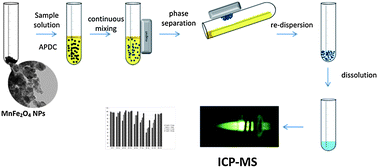The applicability of MnFe2O4 nanoparticles as a new sorbent for group pre-concentration of V, Co, Ni, Cu, Zn, As, Se, Cd and Pb was investigated and compared with that of magnetite nanoparticles. A solid-phase extraction (SPE) of target analytes based on sorption of their hydrophobic complexes with ammonium pyrrolidine dithiocarbamate (APDC) on the surface of unmodified nanoparticles (NPs) was optimized. Magnetic NPs with retained metal complexes were easily separated from the bulk solution by a permanent magnet applied for 5 min. Analyte restoration in the final solution was accomplished by heating with 0.5 mL of 7 mol L−1 nitric acid. The obtained solutions were suitable for continuous nebulization in ICP-MS. Spectral and non-spectral matrix effects for urine analysis (direct and after SPE) were studied and adequate calibration strategies are suggested. Under optimized conditions the magnetically assisted SPE procedure enables enrichment of target analytes by factors of between 7.4 and 10, with linear dynamic ranges of 1–100 μg L−1 for V, Co, Ni, Cd, Pb and 10–1000 μg L−1 for Zn, As, Se and method detection limits in the interval 0.01–0.7 μg L−1. The relative standard deviations (RSD%, for 10 μg L−1 V, Co, Ni, Cd, Pb and for 100 μg L−1 Zn, As, Se, n = 6) were less than 5.5%. The accuracy of the method was evaluated by analysing urine certified reference material Seronorm™ Trace Elements Urine 201205 and obtained recoveries were in the range 85–109%. For correct determination of As and Se in urine, a preliminary microwave sample treatment with a mixture HNO3 + H2O2 was needed, but it led to a worsening of method detection limits. The developed method was successfully applied for analysis of human urine.


 Please wait while we load your content...
Please wait while we load your content...